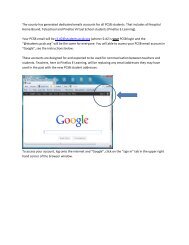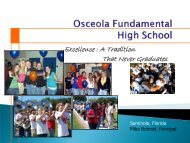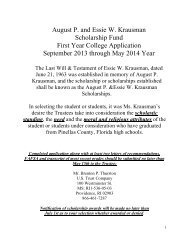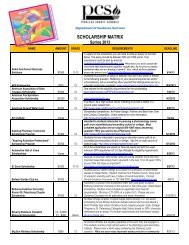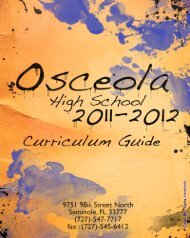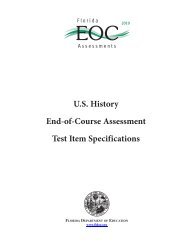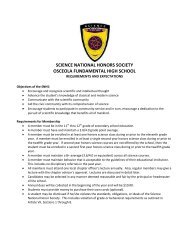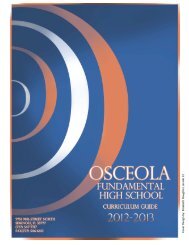AP Human Geography
AP Human Geography
AP Human Geography
You also want an ePaper? Increase the reach of your titles
YUMPU automatically turns print PDFs into web optimized ePapers that Google loves.
<strong>AP</strong> <strong>Human</strong> <strong>Geography</strong><br />
Mr. Mac’s<br />
Expectations, Description and Summer Reading Assignment<br />
As a st udent ent ering int o <strong>AP</strong> Hum an <strong>Geography</strong> you are required<br />
to read the book listed below and complete the attached summer article<br />
assignment.<br />
Summer Reading Assignment:<br />
Friedman, Thomas L. The World Is Flat: A Brief History of the Twenty-First Century.<br />
Farrar, Strous & Girous, 2005.<br />
For the summer, the students of next year's <strong>AP</strong> <strong>Human</strong> <strong>Geography</strong> class will read<br />
and answer questions for the book "The World Is Flat" by Thomas Friedman. This book<br />
was first published in 2005 and updated in 2007. Thomas Lauren Friedman (born July<br />
20, 1953) is an American journalist, columnist and multi Pulitzer Prize winning author.<br />
He is an op-ed contributor to The New York Times, whose column appears twice weekly.<br />
He has written extensively on foreign affairs including global trade, the Middle East and<br />
environmental issues. He has won the Pulitzer Prize three times, twice for International<br />
Reporting (1983, 1988) and once for Commentary (2002). He has been a member of the<br />
Pulitzer Prize Board from 2004 until the present.<br />
Read this book and completely answer the following questions. Provide insight<br />
and examples to back up your responses. Write a 3 page (12pt font double space) review<br />
of the book: summarize Friedman’s central points, discuss any possible weaknesses in his<br />
arguments, and give your own assessment of Friedman’s explanation of the world.<br />
Discussion Questions for Friedman’s: The World Is Flat<br />
From Chapter 1: While I Was Sleeping<br />
1. What is it about the “blat world that both excites Friedman and fills him with dread<br />
2. What does Friedman mean by Globalization 1.0, 2.0, and 3.0<br />
3. What is the “flat-world platform,” what are its three components, and what makes it so<br />
empowering for individuals<br />
4. What is the “touchy-feely” service stuff, and why should we as Americans become good at<br />
it Why should we focus on our personal “value-add”<br />
5. How are the journalism and fast-food industries becoming flat<br />
6. What does it mean that organizational hierarchies are being “challenged from below or are<br />
transforming themselves from top-down structures to more horizontal and collaborative<br />
ones”<br />
From Chapter 2: The Ten Forces That Flattened the World<br />
Flattener #1: The New Age of Creativity<br />
7. What was the significance of the fall of the Berlin Wall on 11/9/89<br />
8. Why do you think Communism makes everyone “equally poor” and capitalism makes<br />
everyone “unequally rich”<br />
9. How does freedom have a flattening effect on societies<br />
10. What are the impact of common standards and the sharing of knowledge Why is this more<br />
likely to happen under democratic capitalism than communism Why is this worth unequal<br />
wealth<br />
11. Who brought down the wall What does it matter who gets the credit<br />
Flattener #2: The New Age of Connectivity<br />
12. What is the difference between the Internet and the World Wide Web<br />
13. What was the significance of Netscape
14. What led to the fiber optic bubble and who did the bubble benefit and harm the<br />
most Why is the overinvestment in fiber optic cable the gift that keeps on giving<br />
15. What was the “Apple-PC-Window flattening phase” and what did it do What was<br />
the “Internet-email-browser phase” and what did it do<br />
Flattener #3: Work Flow Software<br />
16. What was the “first big breakthrough in work flow”<br />
17. What else was needed Explain using the railroad analogy<br />
18. The new foundation created a new platform for what (To be a leader tomorrow and<br />
today, this is a key skill)<br />
Flattener #4: Uploading<br />
19. What is community developed software<br />
20. What are examples of community developed answers<br />
21. What is blogging<br />
22. What is upload content<br />
Flattener #5: Outsourcing<br />
23. What is the significance of India’s seven Institutes of Technology<br />
24. Why and how did India benefit from the U.S.’s overinvestment in bandwidth<br />
25. How is outsourcing related to the success of entrepreneurs and venture capital<br />
firms<br />
Flattener #6: Offshoring<br />
26. How is offshoring different for outsourcing<br />
27. What was the significance of China joining the World Trade Organizations in 2001<br />
28. What is China’s long-run strategy<br />
29. Is offshoring always a lose-lose proposition for the U.S. worker Is it always a winwin<br />
proposition for the U.S. consumer<br />
30. What is holding China back<br />
Flattener #7: Supply-Chaining<br />
31. What is supply-chaining, the “Wal-Mart Symphony”<br />
32. What are the two biggest challenges to developing a global supply chain<br />
33. What is the “coefficient of flatness”<br />
34. What three activities accounted for Wal-Mart’s success once it began purchasing<br />
directly from manufacturers<br />
35. What are Wal-Mart’s low prices derived from<br />
Flattener #8: Insourcing<br />
36. What is “insourcing,” who does it, and how is it distinct from “outsourcing”<br />
Flattener #9: In-forming<br />
37. How is “in-forming” the analog to “uploading”<br />
38. Why is in-forming “enormously flattening” and “enormously frightening”<br />
Flattener #10: The Steroids<br />
39. Computing: What does computing consist of<br />
40. Instant messaging and file sharing…<br />
41. Making phone calls over the internet (VoIP) (IBASIS)…<br />
42. Videoconferencing…<br />
43. Computer graphics…<br />
44. Wireless…
From Chapter 3: Triple Convergence<br />
45. What in brief, is the “tripe convergence”<br />
46. Who are the people engaging in the triple convergence in terms of ethic of<br />
education<br />
47. Who are the “zippies”<br />
48. In order to compete in this new world, what must Americans – who have been<br />
leaders in innovation – now do<br />
49. What events helped cause the U.S. government to lose focus regarding the triple<br />
convergence and its impact<br />
From Chapter 4: The Great Sorting Out<br />
50. What does it mean that we are moving from a vertical)”command and control”)<br />
world to a horizontal (“connect and collaborate”) one<br />
51. What does the flattening world mean for culture and the values of a particular<br />
culture<br />
52. What must happen in order to protect and enhance the companies and countries of<br />
origin<br />
53. How “flat” should government be What are the tradeoffs<br />
54. What is the difference between “social/cultural conservatives” and the “business<br />
wing” of the Republican Party<br />
From Chapter 5: America and Free Trade<br />
55. Friedman says that the U.S. should promote free trade, but he also says that the<br />
U.S., then, needs to pursue at least two complementary strategies<br />
56. Friedman says there may be a limit to “the number of goods factory jobs in the<br />
world,” but not a limit to “the number of idea-generated jobs in the world.” What<br />
does he mean<br />
57. Explain the flow of jobs from “new” jobs to “commoditized” jobs”<br />
From Chapter 6: The Untouchables<br />
58. What should we be telling our kids about the “flattening” world Do you agree<br />
59. The key in finding your calling and in surviving in the flat world is to find what type<br />
of jobs<br />
60. How can one make oneself “untouchable” in this new world What are the three<br />
broad categories Friedman discusses<br />
61. Who are the “New Middlers” What skills do they have<br />
From Chapter 7: The Right Stuff<br />
62. What skill and attitudes are included in the right stuff<br />
63. What is the meaning of the formula: CQ + PQ > IQ<br />
64. What does Friedman mean by the phrases “high concept” and “high touch”<br />
65. How does one nurture her or his “right brain” skills<br />
66. What does Friedman mean when he says “What makes America unique is not Enron<br />
but Eliot Spitzer”<br />
67. What is U.S.’s “secret sauce”<br />
From Chapter 8: The Quiet Crisis<br />
68. What are the “dirty little secrets: about the U.S.<br />
a. Dirty little secret #1<br />
b. Dirty little secret #2<br />
b. Dirty little secret #3<br />
b. Dirty little secret #4
. Dirty little secret #5<br />
b. Dirty little secret #6<br />
From Chapter 9: This is Not a Test<br />
69. What is “compassionate flatism”<br />
70. What was IBM’s (Gerstner’s) new idea about guaranteed employment What did<br />
IBM promise its workers<br />
71. If workers are to become more responsible for managing their own career, risks, and<br />
economic security, what must government help provide What must companies<br />
provide<br />
72. What effects does educating at the tertiary level have<br />
73. What should be the new “social contract” between workers and employers<br />
74. Why is one a fool if one is a “let ‘er rip free-market flatist”<br />
75. What else must education do besides developing cognitive skills<br />
From Chapter 10: The Virgin of Guadalupe<br />
76. What three basic things must a country get right if it wants to develop when the<br />
world becomes flat<br />
77. What is reform wholesale What is reform retail What does reform retail require a<br />
country to do<br />
78. Does capital “just move around the world looking for the cheapest labor” What<br />
does Ireland’s experience – and that of Haiti and Bangladesh – tell us<br />
79. What determines how “outward” a culture is What determines how “inward” a<br />
culture is How does relate to the Muslim countries<br />
80. What does tolerance breed (What do you suppose breeds tolerance)<br />
From Chapter 11: How Companies Cope<br />
81. What does it mean for a company to “dig inside of itself as opposed to “building<br />
wall<br />
82. How do small companies act big How do big companies act small<br />
83. What is “deep collaboration,” “cross-pollination,” and “concurrent engineering”<br />
How is it different from working in stages<br />
84. What is a “social entrepreneur<br />
From Chapter 12: The Unflat World<br />
85. What is the difference between a “technological determinist” and a “historical<br />
determinist” What is Friedman What are you<br />
86. What do some Muslim extremists (and some conservative Christian extremists)<br />
want What is the relationship of what they want and building trust<br />
87. What is the significance of human dignity and humiliation How do we encourage<br />
behaviors that dignify and discourage behaviors that humiliate
Course Description: <strong>AP</strong> Hum an <strong>Geography</strong> is designed t o be a college int roduct ory<br />
geography course. It aim s t o int roduce st udent s t o t he basic concept s of hum an<br />
geography and provide a geographic fram ew ork for t he analysis of current w orld<br />
problem s t hrough t he use of case st udies. The course develops t he st udent s’ abilit y<br />
t o ask geographic quest ions; acquire, organize and analyze geographic inform at ion;<br />
and answ er geographic quest ions.<br />
St udent s em ploy spat ial concept s and landscape analysis t o analyze hum an so cial<br />
organizat ion and it s environm ent al consequences. They also learn about t he<br />
m et hods and t ools geographers use in t heir science and pract ice.<br />
Course Objectives:<br />
-List and explain t he building blocks of hum an geography<br />
-Ident ify pat t erns of populat ion d ist ribut ion, grow t h and decline and connect t hese<br />
pat t erns t o different st ages of econom ic developm ent<br />
-Ident ify different t ypes of m igrat ion and explain t he reasons for each<br />
-Describe t he origins, developm ent and dist ribut ion of different languages and<br />
explain how language can be eit her a unifying or a divisive fact or<br />
-Describe t he origins, developm ent and dist ribut ion of different religions and explain<br />
how religion can be eit her a unifying or a divisive fact or<br />
-Define a nat ion-st at e and ident ify t he fact o rs t hat det erm ine t he pow er/ inf luence a<br />
nat ion-st at e has in t he w orld com m unit y<br />
-Describe how econom ic developm ent is m easured and ident ify possible pat hs t o<br />
econom ic developm ent<br />
-Explain t he differences bet w een int ensive and ext ensive subsist ence agricult ure<br />
and t he differences bet w een int ensive and ext ensive com m ercial agricult ure<br />
-Describe t he dist ribut ion pat t ern of indust ry and explain t he fact ors underlying<br />
indust rial locat ion<br />
decisions<br />
-Explain t he origin, dist ribut ion and grow t h of set t lem ent areas and explain w hy<br />
t hese people and<br />
act ivit ies display part icular spat ial pat t erns<br />
-Apply geographic m et hods t o t he cont em porary issues of energy, pollut ion and<br />
food product ion<br />
-Use and t hink about m aps and spat ial dat a set s<br />
-Underst and and int erpret t he im plicat ions of associat ions am ong phenom ena in<br />
places<br />
-Recognize and int erpret at different scales t he relat ionships am ong pat t erns and<br />
processes<br />
-Define regions and evaluat e t he regionalizat ion process<br />
-Charact erize and analyze changing int erconnect ions am on g places.<br />
Attendance and Expectations: The st udent is expect ed t o act ively part icipat e in all<br />
class act ivit ies. Therefore, st udent s should at t end all class sessions and review<br />
m at erial before each class m eet ing. The st udent needs t o be prepared for any and<br />
every aspect of t his course. Excused absences w ill be considered t o an illness, fam ily<br />
crisis, or approved inst it ut ional act ivit y. A m issed class session due t o any<br />
inst it ut ional act ivit y m ust be verified in w rit ing<br />
t o m e in order for it t o be excused. Unforeseeable absences w ill not be excused<br />
unless t he st udent provides t he inst ruct or docum ent at ion and verificat ion w it hin<br />
one w eek of t he m issed class. The st udent is expect ed t o m ake up an exam m issed<br />
w it hin one w eek ret urning t o class at a t im e m ut ually decided upon w it h t he<br />
inst ruct or. Lat e w ork is not accept ed unless due t o an absence w it h in conjunct ion<br />
w it h t he reasoning above. Each student is required to take the <strong>AP</strong> exam<br />
for this course.<br />
Plagiarism: Plagiarism is using ot her’s w ork, ideas, or passages and represent ing<br />
t hem as your ow n. This
unet hical pract ice of plagiarism eit her on a w rit t en/ oral assignm ent or exam w ill<br />
result in a failing grade for t he<br />
assignm ent and possibly t he course.<br />
Course Requirements:<br />
-Class at t endance and part icipat ion<br />
-Exam s based on in -class experiences, present at ions, and reading assignm ent s<br />
-Project s assigned t hroughout year<br />
-In class and hom ew ork assignm ent s



